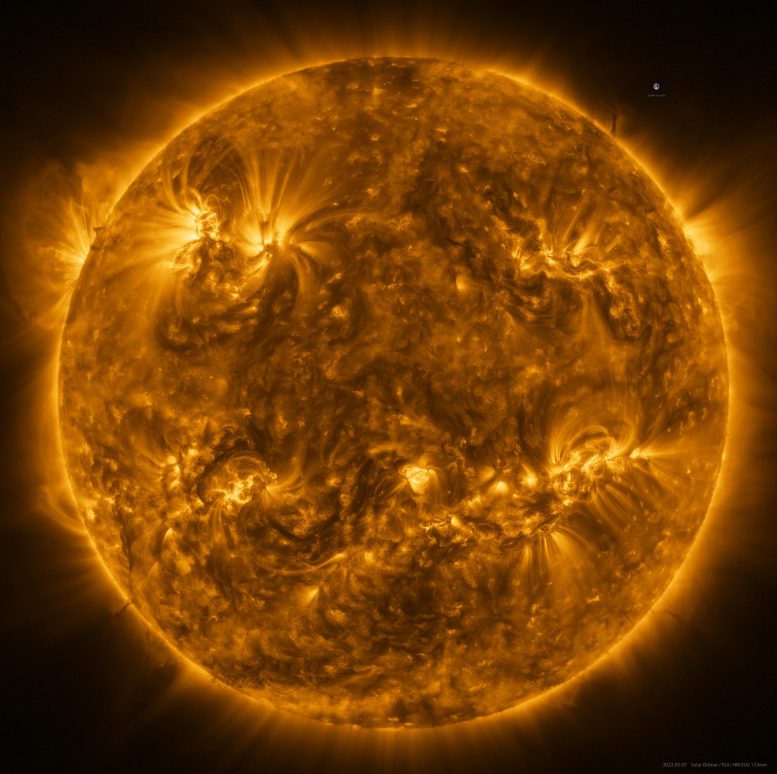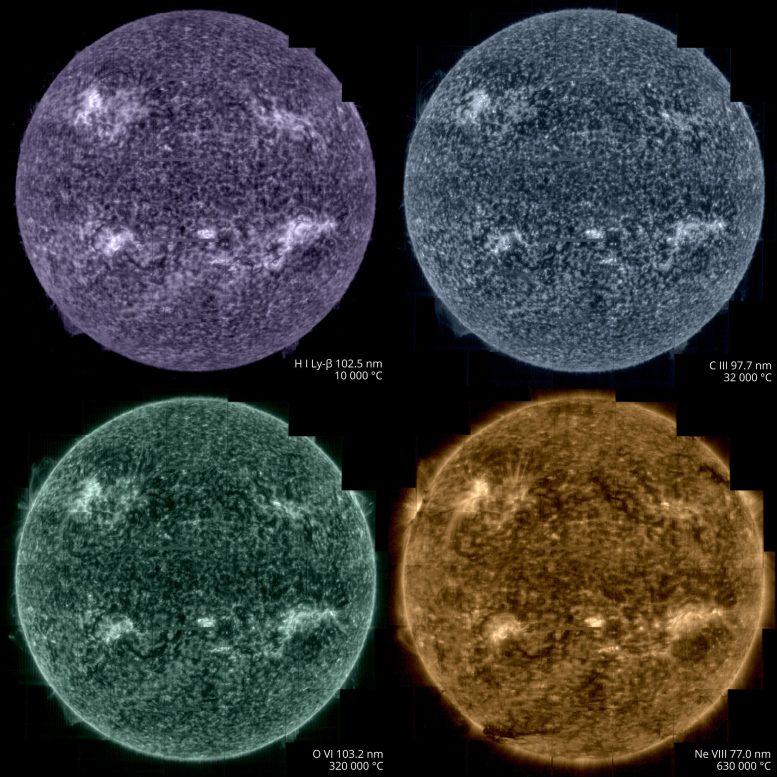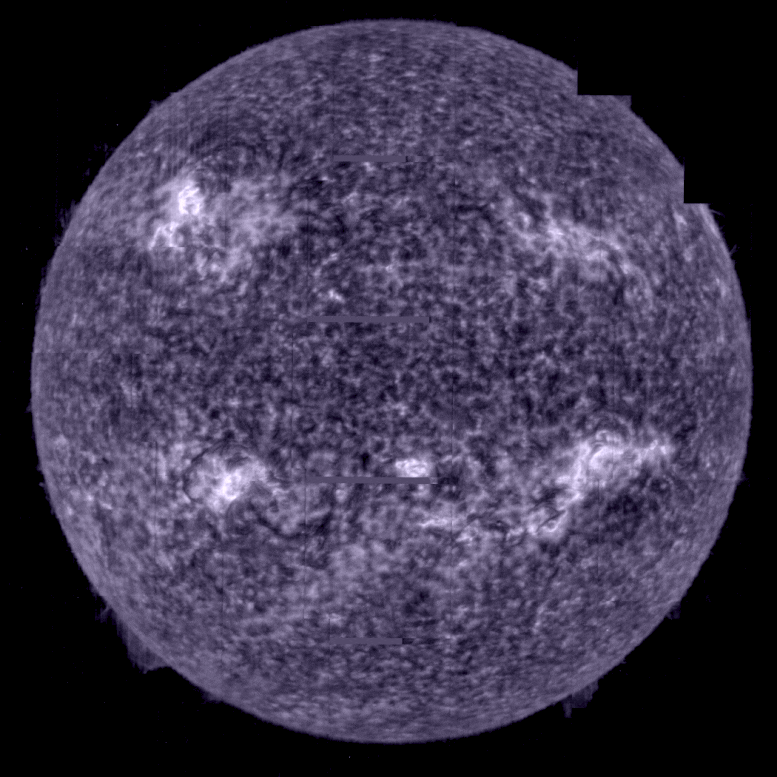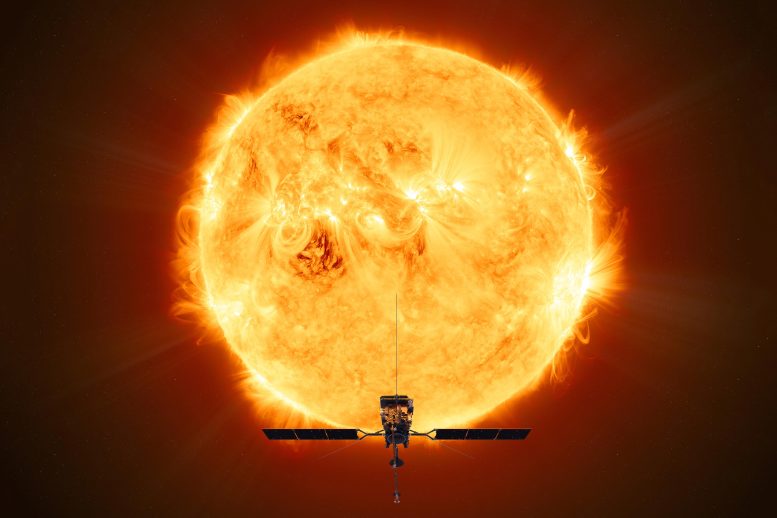Animazione del Solar Orbiter dell’Agenzia Spaziale Europea. Credito: ESA/Medialab
Le ultime immagini di Solar Orbiter mostrano il pieno sole con dettagli senza precedenti. È stata scattata il 7 marzo 2022, quando la navicella stava transitando direttamente tra la Terra e il Sole.
Una delle immagini catturate dall’Extreme Ultraviolet Imager (EUI) è l’immagine con la più alta risoluzione del disco del pieno sole e dell’atmosfera esterna, la corona, mai scattata.
Un’altra immagine presa dallo strumento Spectral Imaging of the Coronal Environment (SPICE) rappresenta la prima immagine completa del Sole in 50 anni e la migliore immagine presa lungo la lunghezza d’onda beta di Lyman della radiazione ultravioletta emessa dall’idrogeno gassoso.
Le immagini sono state scattate quando l’orbita solare si trovava a circa 75 milioni di chilometri di distanza, a metà strada tra il nostro mondo e la sua stella madre. Il telescopio ad alta risoluzione dell’EUI cattura immagini con una risoluzione spaziale così elevata che, a quella distanza ravvicinata, è necessario un mosaico di 25 singole immagini per coprire l’intero Sole. Scattata una per una, l’immagine completa è stata acquisita in un periodo di oltre quattro ore perché ogni pezzo impiega circa 10 minuti, compreso il tempo impiegato dalla navicella spaziale per puntare da una parte all’altra.

Il Sole visto dal Solar Orbiter alla luce ultravioletta estrema da una distanza di circa 75 milioni di km. L’immagine è un mosaico di 25 singole immagini scattate il 7 marzo 2022 dal telescopio ad alta risoluzione dello strumento di imaging ultravioletto (EUI). Questa immagine è stata scattata a una lunghezza d’onda di 17 nanometri, nella regione ultravioletta estrema dello spettro elettromagnetico, rivelando l’atmosfera superiore del sole, la corona, che ha una temperatura di circa un milione di gradi Celsius. È inclusa anche un’immagine terrestre della scala a ore 2. Crediti: ESA e NASA/Solar Orbiter/EUI Team; Elaborazione dati: E. Kraaikamp (ROB)
In totale, il immagine finale Contiene più di 83 milioni di pixel in una griglia di 9148 x 9112 pixel. Per fare un confronto, questa immagine ha una risoluzione dieci volte migliore di quella che può visualizzare uno schermo TV 4K.
EUI raffigura il Sole a una lunghezza d’onda di 17 nanometri, nella regione ultravioletta estrema dello spettro elettromagnetico. Questo rivela l’atmosfera superiore del sole, la corona, che ha una temperatura di circa un milione di gradi[{” attribute=””>Celsius.

Solar Orbiter took images of the Sun on March 7, from a distance of roughly 75 million kilometres, using its Spectral Imaging of the Coronal Environment (SPICE) instrument. SPICE takes simultaneous “spectral images” at several different wavelengths of the extreme ultraviolet spectrum by scanning its spectrometer slit across a region on the Sun. The different wavelengths recorded correspond to different layers in the Sun’s lower atmosphere. Purple corresponds to hydrogen gas at a temperature of 10,000°C, blue to carbon at 32,000°C, green to oxygen at 320,000°C, yellow to neon at 630,000°C. Each full-Sun image is made up of a mosaic of 25 individual scans. It represents the best full Sun image taken at the Lyman beta wavelength of ultraviolet light that is emitted by hydrogen gas. Credit: ESA & NASA/Solar Orbiter/SPICE team; Data processing: G. Pelouze (IAS)
At the 2 o’clock (near the image of the Earth for scale) and 8 o’clock positions on the edges of the Sun, dark filaments can be seen projecting away from the surface. These ‘prominences’ are prone to erupt, throwing huge quantities of coronal gas into space and creating ‘space weather’ storms.
In addition to EUI, the SPICE instrument was also recording data during the crossing. These too needed to be pieced together as a mosaic.
SPICE is designed to trace the layers in the Sun’s atmosphere from the corona, down to a layer known as the chromosphere, getting closer to the surface. The instrument does this by looking at the different wavelengths of extreme ultraviolet light that come from different atoms.

Taking the Sun’s temperature. Credit: ESA & NASA/Solar Orbiter/SPICE team; Data processing: G. Pelouze (IAS)
In the SPICE sequence of images purple corresponds to hydrogen gas at a temperature of 10,000°C, blue to carbon at 32,000°C, green to oxygen at 320,000°C, yellow to neon at 630,000°C.
This will allow solar physicists to trace the extraordinarily powerful eruptions that take place in the corona down through the lower atmospheric layers. It will also allow them to study one of the most puzzling observations about the Sun: how the temperature is rising through the ascending atmospheric layers.
Usually the temperature drops as you move away from a hot object. But above the Sun, the corona reaches a million degrees Celsius whereas the surface is only about 5000°C. Investigating this mystery is one of the key scientific objectives of Solar Orbiter.
The images were taken on 7 March, precisely when Solar Orbiter crossed the Sun-Earth line, so the images can be compared with Earth-bound solar instruments and cross-calibrated. This will make it easier to compare results from different instruments and observatories in future.
On March 26, Solar Orbiter reaches another mission milestone: its first close perihelion. The spacecraft is now inside the orbit of Mercury, the inner planet, taking the highest resolution images of the Sun it can take. It is also recording data on the solar wind of particles that flows outwards from the Sun.
And this is just the start, over the coming years the spacecraft will repeatedly fly this close to the Sun. It will also gradually raise its orientation to view the Sun’s previously unobserved polar regions.
Solar Orbiter is a space mission of international collaboration between ESA and NASA.

“Giocatore. Aspirante evangelista della birra. Professionista della cultura pop. Amante dei viaggi. Sostenitore dei social media.”

